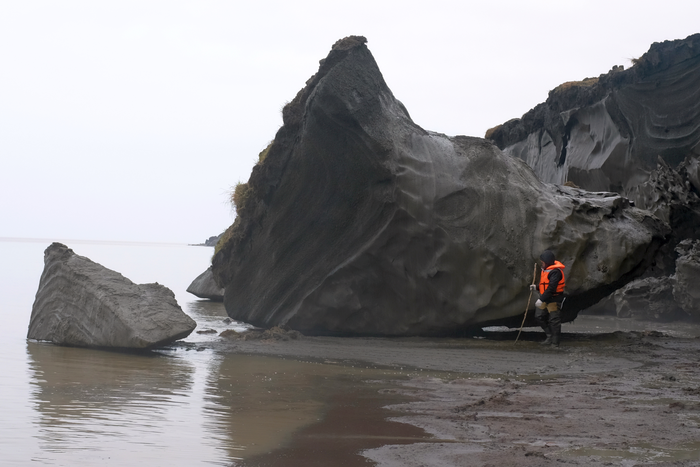The coasts of the Arctic are being destroyed by erosion. The warming of the soil, resulting in ruptures and slumping, could threaten significant infrastructures and endanger the security of local populations.
 Scientist investigating coastal erosion caused by thawing permafrost near Bykovsky Peninsula, Laptev Sea, Siberia, Russia. Image Credit: AWI/Paul Overduin.
Scientist investigating coastal erosion caused by thawing permafrost near Bykovsky Peninsula, Laptev Sea, Siberia, Russia. Image Credit: AWI/Paul Overduin.
Additionally, such processes tend to release carbon stored in soils into the ocean, which could change the role of the Arctic Ocean as a significant storehouse of carbon and other greenhouse gases. Also, they could contribute to the increase in climate change.
So far, understanding of the speed and magnitude of such variations has been lacking for the future. With the help of a new combination of computational models, researchers at Universität Hamburg have for the first time determined them for the whole of the Arctic.
We have run through a range of scenarios, depending on how much greenhouse gases humanity will emit in the coming years. According to the study, not only is more and more land mass being lost in absolute terms; with each degree of temperature increase, the annual rate of erosion increases–in meters, but also in millions of tons of carbon released.
Dr. David Nielsen, Study Lead Author, Cluster of Excellence for Climate Research CLICCS, Universität of Hamburg
If greenhouse gas emissions stay unchecked or continue to increase, the rate could more than double by 2100. This could imply erosion losses of up to 3 m annually.
The new study offers significant data for coastal safety, and for social and political planning in the regions that are affected. Consequently, evaluations of future erosion rates provide an indispensable basis for the study of interactions between thawing permafrost and the discharge of carbon in the Arctic. These are the aspects that might be mutually reinforcing.
Our findings also show that a shift toward greater sustainability and significantly lower greenhouse gas emissions could slow the acceleration in the second half of the century. However, it won’t be possible to stop the loss of land mass entirely.
Dr. David Nielsen, Study Lead Author, Cluster of Excellence for Climate Research CLICCS, Universität of Hamburg
Along with other scientists from Universität Hamburg, the Max Planck Institute for Meteorology, the Alfred Wegener Institute, Helmholtz Centre for Polar and Marine Research, and the German Meteorological Service, Nielsen has, for the first time, estimated the future balance for the Arctic as a whole — a significant achievement, as coastal erosion varies considerably from region to region.
Nielsen added, “In the Arctic, erosion is always a combination of thermal and mechanical factors. His calculations, therefore, link existing Earth system models with observational data, wave simulations, and climate reanalyzes.
Depending on the location and shape of the respective coast, we expect to see varying wave heights. With increasing temperature, the range of the waves also increases, because the sea ice disappears. In addition, the ice-free period in the summer is lengthened, making coasts even more vulnerable.
Dr. David Nielsen, Study Lead Author, Cluster of Excellence for Climate Research CLICCS, Universität of Hamburg
Dr. David Nielsen conducts research on plausible and possible climate futures at Universität Hamburg’s Cluster of Excellence CLICCS (Climate, Climatic Change, and Society). He is also a member of Universität Hamburg’s Center for Earth System Research and Sustainability (CEN).
This study was conducted in close collaboration with the project “Nunataryuk” and was supported by the European Research Program Horizon 2020.
Journal Reference:
Nielsen, D. M., et al. (2022) Increase in Arctic coastal erosion and its sensitivity to warming in the twenty-first century. Nature Climate Change. doi.org/10.1038/s41558-022-01281-0.